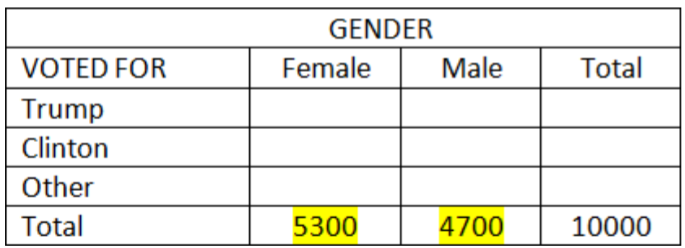5.7: Tablas de contingencia (de dos vías)
- Page ID
- 151847
Tablas de contingencia, también conocidas como tabulaciones cruzadas, tabulaciones cruzadas o tablas de dos vías, es un método para mostrar los recuentos de las respuestas de dos variables categóricas a partir de datos.
Ejemplo: Accidentes y DUI
Se les preguntó a 1000 conductores si estuvieron involucrados en un accidente en el último año. También se les preguntó si durante este tiempo, eran DUI, manejando bajo los efectos del alcohol o las drogas. Los totales se resumen en una tabla de contingencia:
| Accidente | Sin Accidente | Total | |
|---|---|---|---|
| DUI | 70 | 130 | 200 |
| No DUI | 30 | 770 | 800 |
| Total | 100 | 900 | 1000 |

Solución
En la tabla, cada columna representa una opción para la pregunta del accidente y cada fila representa una opción para la pregunta de DUI.
Las probabilidades marginales se pueden determinar a partir de la tabla de contingencia utilizando los valores totales externos para cada evento divididos por el tamaño total de la muestra.
- Probabilidad de que un conductor tuviera un accidente\(P(A)\) = = 100/1000 = 0.10
- Probabilidad de que un conductor no fue DUI\(P(D') = 1 ‐ P(D)\) = = 1 ‐ 200/1000 = 0.80
Las probabilidades conjuntas se pueden determinar a partir de la tabla de contingencia utilizando los valores internos de la tabla divididos por el tamaño total de la muestra.
- Probabilidad que un conductor tuvo un accidente y fue\(P(A \text{ and } D)\) DUI= = 70/1000 = 0.07
- Probabilidad que un conductor tuvo un accidente o fue\(P(A \text{ or } D)\) DUI= = (100+200‐70) /1000 = 0.23
Las probabilidades condicionales se pueden determinar a partir de la tabla de contingencia utilizando los valores internos de la tabla divididos por el valor total externo del evento condicional.
- Probabilidad de que un conductor fuera DUI dado que el conductor tuvo un accidente\(P(D|A)\) = = 70/100 = 0.70
- Probabilidad de que un conductor de DUI tuviera un accidente\(P(A|D)\) = = 70/200 = 0.35
Crear una tabla de dos a partir de probabilidades reportadas
Podemos crear una hipotética tabla de dos vías a partir de probabilidades tabuladas cruzadas reportadas, como la encuesta de salida de CNN para las elecciones presidenciales de 2016:


Paso 1: Elija un número total conveniente. (Esto se llama la base de la tabla).

Radix elegido = 10000 votantes aleatorios
Paso 2: Determinar los valores externos de la tabla multiplicando la base por las probabilidades marginales para el género.

Total Mujeres = (0.53) (10000) = 5300
Total Hombres = (0.47) (10000) = 4700
Paso 3: Determinar los valores internos de la tabla multiplicando el total de género apropiado por las probabilidades condicionales de las encuestas de salida.

Trump Mujer = (0.41) (5300) = 2173
Clinton Mujer = (0.54) (5300) = 2862
Otras mujeres = (0.05) (5300) = 265
Trump Masculino = (0.52) (4700) = 2444
Clinton Hombre = (0.41) (4700) = 1927
Otro hombre = (0.057) (4700) = 329
Paso 4: Agrega cada fila para obtener los totales de fila.

Trump = 2173 + 2444 = 4617
Clinton = 2862 + 1927 = 4789
Otro = 265 + 329 = 594
De la última columna, ahora podemos obtener las probabilidades marginales (que están ligeramente desviadas de la votación real debido al redondeo en las encuestas de salida): Donald Trump recibió 46%, Hillary Clinton recibió 48% y otros candidatos recibieron 6% del total de votos.


